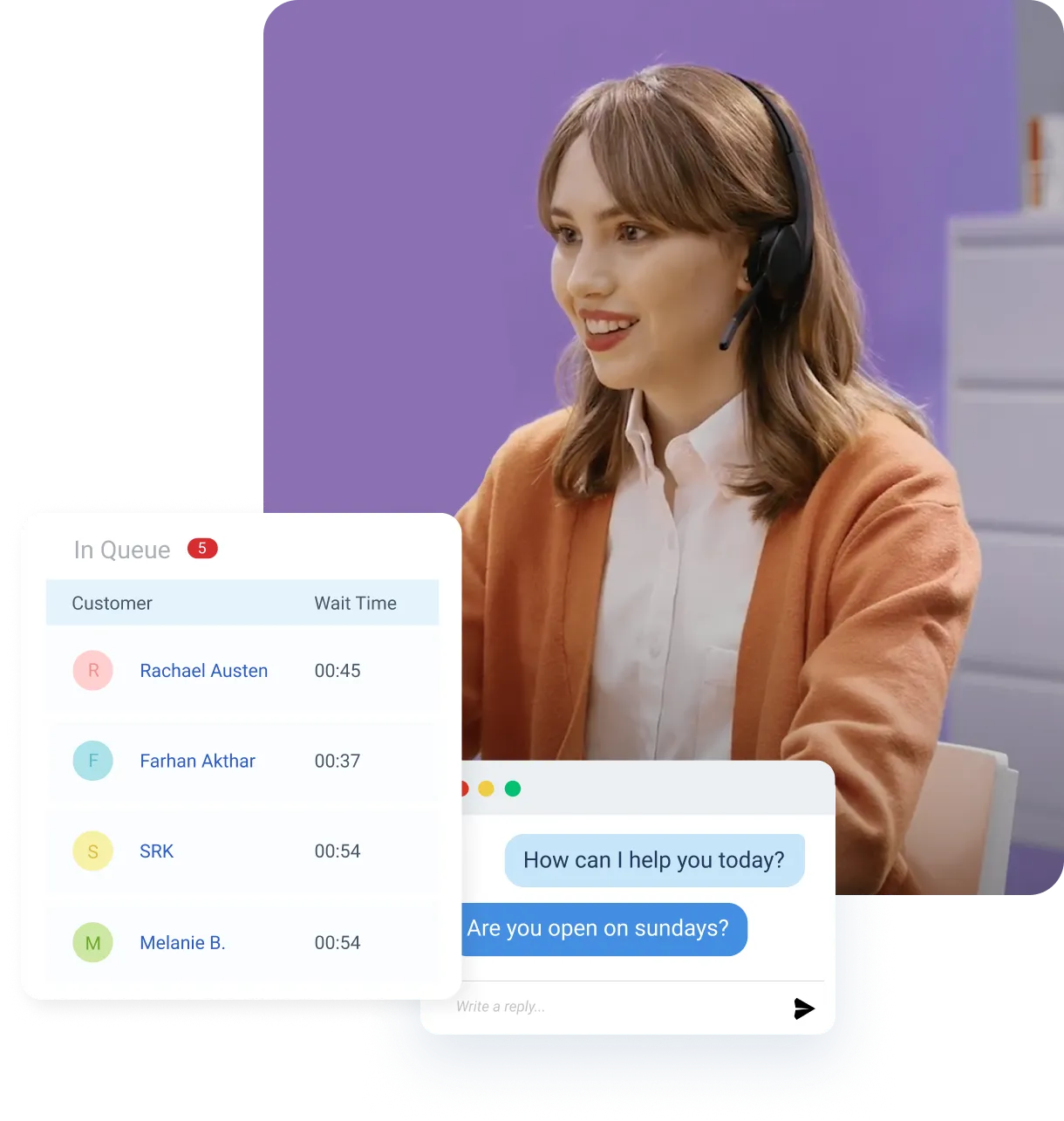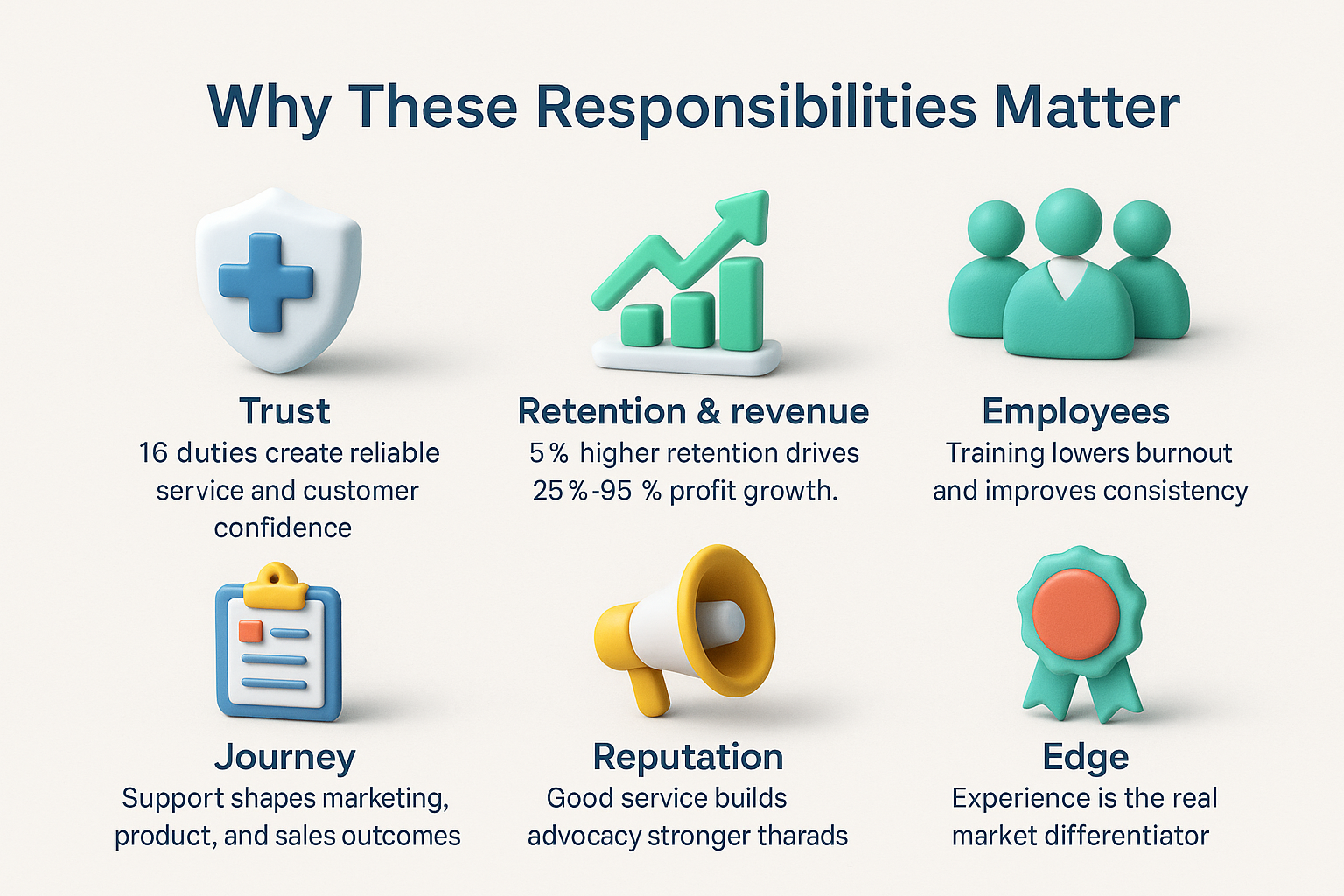Customer service is one of the most important parts of business today. It defines how customers view a company and how long they stay loyal. Clear roles and well executed tasks turn ordinary support into a powerful advantage. Professionals who master these duties improve satisfaction and trust. This article reviews the top 16 customer service responsibilities and duties in detail and adds insights on trends, forecasts, and skills needed for the future.

1. Providing Timely and Accurate Responses
Customers expect answers fast. A delay of even a few hours can create frustration. In fact, Harvard Business Review reported that timely responses are strongly linked with retention. Accuracy is equally important. Wrong information is worse than none and can harm credibility.
To manage both speed and accuracy, many teams combine human agents with automation. Chat assistants can provide quick answers while specialists handle complex issues. Companies that maintain response time under 24 hours see higher satisfaction levels than those that take longer.
Practical advice: create a knowledge base that is updated weekly. This reduces errors and ensures every agent works with the same facts.
2. Resolving Customer Complaints Effectively
Every complaint is an opportunity to build loyalty. According to the American Customer Satisfaction Index, efficient resolution of complaints is a top driver of positive outcomes. Customers who see their issues addressed quickly are more likely to return than those who never complain.
The key is to listen carefully before suggesting solutions. Do not rush into defense. Instead, validate the concern, then present clear steps toward a fix. Offer follow up when needed.
Rare detail: customers who receive a resolution within 48 hours report up to 30% higher satisfaction compared with those who wait longer.
3. Building Strong Customer Relationships
Transactions are not enough to retain clients. Empathy and personalized care create bonds that last. The McKinsey study on consistency shows that repeated positive experiences build trust.
Simple actions matter. Remembering a customer’s name or past order can feel more important than a discount. Loyalty programs support this but the human touch is still the foundation.
Advice: train agents to note small details during calls and chats. These notes should be added to the system and used in future conversations.

4. Managing Customer Feedback and Suggestions
Feedback is a direct channel from users to the company. Collecting it in structured form helps improve both product and service. Pew Research Center surveys show that customers feel valued when their voices influence change.
Good practice includes using surveys after resolution, creating open suggestion channels, and reviewing responses monthly. Close the loop by sharing visible updates that came from feedback.
Forecast: within the next five years companies will invest more in predictive analytics that use feedback to anticipate future needs.
5. Handling Inquiries Across Multiple Channels
Support no longer exists in a single place. Customers use phone, email, chat, and social media. They expect the same tone and quality in all. If one channel is weak it hurts the brand image.
The Graphlogic Generative AI & Conversational Platform can integrate these channels. It reduces the gap between them and allows a unified customer journey. Consistency builds trust and prevents confusion.
Advice: assign one team to monitor tone and alignment across channels. This avoids the problem of mixed messages between platforms.
6. Maintaining Product and Service Knowledge
Knowledge is the base of trust. Customers rely on agents for accurate information. A lack of clarity leads to repeat contacts and lower satisfaction. The Journal of Service Research confirms that training reduces repeat inquiries.
Set up weekly product updates. Create short quizzes for agents to keep knowledge active. Encourage team members to test new features before release.
Practical tip: record short video walkthroughs and share them internally. Visual training saves time and improves retention.
7. Upselling and Cross Selling Products
Upselling is often misunderstood as aggressive sales. In reality, it can be a natural extension of customer care. If a representative understands the customer’s needs, suggesting additional features or products can add value.
For example, recommending a premium plan that saves the customer money over time is a win for both sides. The key is timing. Upsell only when the base problem is solved.
Forecast: in the next three years we will see more AI tools that suggest upsell options in real time based on customer history.

8. Ensuring Data Privacy and Security
Data privacy is now a top expectation. Customers want to know their personal information is safe. Strict regulations such as GDPR in Europe and CCPA in California define clear rules. Failing to comply can lead to high fines and reputational damage.
Advice: create clear scripts that explain privacy practices in plain language. Customers do not trust legal jargon. Simple explanations improve confidence.
9. Collaborating with Internal Teams
Service teams cannot solve everything alone. They need cooperation from sales, technical staff, and product development. Internal alignment prevents slow responses and customer frustration.
Best practice: use shared digital boards where support issues are tracked until resolved. Everyone can see progress and add updates. This reduces repeated emails and lost messages.
10. Tracking and Reporting Customer Interactions
Every conversation should be documented. This builds a record that helps with future interactions. It also creates data for performance analysis.
Tracking interactions highlights trends such as common complaints or product gaps. Reports should be reviewed weekly by management.
Advice: standardize fields for logging. Avoid free text only, which is hard to analyze.

11. Educating Customers on Product Usage
Good service also means teaching. Clear education reduces errors and frustration. Tutorials, FAQs, and step by step guides are effective.
The Graphlogic Text-to-Speech API allows companies to create audio guides for accessibility. This is valuable for customers with vision limitations or those who prefer listening.
Advice: measure the impact of education by tracking whether customers who complete tutorials contact support less often.
12. Managing Difficult Customers
Every team faces tough situations. Angry or demanding customers are part of the job. Success depends on patience and professionalism.
Train staff to use calming phrases and redirect focus to solutions. Offer clear timelines for resolution. Avoid taking negative language personally.
Rare fact: studies show that when agents acknowledge frustration within the first 30 seconds, call length decreases by up to 15%.
13. Meeting Key Performance Indicators (KPIs)
KPIs help measure performance. Common indicators include resolution time, satisfaction scores, and first contact resolution. Balanced targets prevent teams from focusing on speed alone.
Advice: review KPIs monthly and adjust goals when business priorities shift. Encourage feedback from agents about which targets feel realistic.
14. Staying Calm Under Pressure
Customer service is often stressful. Agents handle high volumes and emotional situations. Emotional resilience is essential to avoid burnout.
Simple methods such as short breaks, hydration, and breathing exercises improve balance. Managers should monitor workload and provide wellness support.
Forecast: more companies will include mental health programs in service departments within the next five years.
15. Adapting to New Tools and Technologies
Customer service tools evolve rapidly. From chatbots to advanced reporting dashboards, technology is central to support. Adaptation requires constant training.
Agents who embrace new tools often deliver faster and more accurate results. Resistance to change creates delays.
Practical tip: create a digital sandbox where staff can test tools without pressure.

16. Promoting a Positive Company Image
Every interaction shapes perception. Representatives act as brand ambassadors. Polite, empathetic communication promotes trust. Even a small mistake can spread quickly through social media.
Encourage agents to focus on clarity and positivity. Recognize that every call, email, or chat is also a form of marketing.
Why These Responsibilities Matter
Customer trust as the foundation
The 16 responsibilities listed above are the backbone of excellent service. They are not random tasks but interconnected elements that together define customer trust. When a company delivers timely responses, resolves complaints, and builds relationships, it creates a structure where customers feel valued and supported. This feeling often matters more than price or product features.
Retention and revenue impact
These responsibilities also reduce churn. Customers who feel heard are less likely to leave, even when competitors offer lower prices. Retention has a direct link to revenue. Studies in service economics show that a 5% increase in customer retention can lead to profit growth of 25% to 95%. Such numbers prove that support is not a cost center but a growth engine.
Employee satisfaction and stability
Investing in these skills also improves employee satisfaction. Service representatives who have clear guidelines and strong training feel more confident in their work. This reduces burnout and turnover. A stable workforce leads to better consistency in communication and fewer mistakes in handling cases.
Influence on the customer journey
Companies that master these responsibilities also invest in the entire customer journey. Support is no longer an isolated department. It influences marketing by shaping brand reputation. It influences product development by delivering feedback. It influences sales by creating opportunities for upsell and cross sell. Every touchpoint can create either trust or frustration, and the outcome depends on how well these responsibilities are executed.
Reputation and advocacy
Quality service builds a reputation that money cannot easily buy. Advertising may bring attention, but consistent positive experiences create advocates who recommend the brand to others. Word of mouth remains one of the strongest drivers of growth in any industry. This reputation is also resilient. A company that has a history of reliable service can recover faster from mistakes than one without that foundation.
Competitive differentiation
Another reason these responsibilities matter is competitive differentiation. Many products are similar in features and price. What sets one company apart is how it treats its customers when issues arise. A sustainable competitive edge is built not only on innovation but also on consistent, respectful, and effective service. In markets where technology is easy to copy, customer experience becomes the true barrier to entry for competitors.

Trends and Forecasts in Customer Service
Human expertise combined with technology
The future of customer service will combine human expertise with advanced technologies. Artificial intelligence will take over routine inquiries such as balance checks, password resets, or shipment tracking. This will free human agents to focus on complex cases that require judgment and empathy. Voice recognition systems will improve accuracy in real time conversations. Text analysis tools will help detect customer sentiment early and guide agents toward better responses.
Rise of personalization
Personalization will grow as a major expectation. Customers already want brands to understand context without repeated explanations. Within the next 5 years, predictive analytics will allow companies to anticipate needs before they are spoken. For example, systems may alert an agent that a customer is likely to request an upgrade based on past behavior. This reduces friction and creates smoother journeys.
Transparency and ethical AI
Transparency is another powerful trend. Customers are more aware of how companies collect and use data. They want control and clarity. Explaining data practices in plain language will become a core responsibility. Companies that fail to do so will face both reputational damage and regulatory pressure. Ethical AI practices will also move into the spotlight. Customers will ask not only if automation is efficient but also if it is fair.
Forecast for 2030
Forecasts for 2030 suggest that around 70% of service interactions may involve some level of automation. Yet automation alone will not define success. The unique value of human agents will remain empathy, creativity, and problem solving. Machines can recognize patterns but they cannot replicate genuine care. Successful companies will combine both.
Proactive support
Another trend is proactive support. Instead of waiting for issues, companies will reach out in advance. For example, a system might alert a customer about a possible delay before they notice it themselves. This approach reduces complaints and shows reliability.

Globalization and cultural alignment
Globalization will also shape service. Customers interact with companies across borders and time zones. They expect consistent quality everywhere. To meet this, companies will invest in multilingual support, cultural training, and always available platforms.
Sustainability and values
Sustainability will influence service too. Customers increasingly want to know not only what they buy but also how responsibly a company operates. Service teams will need to communicate environmental and social commitments clearly. This will extend the role of service from problem solving to representing corporate values.
Balance between automation and empathy
In summary, the future of customer service is not only about technology. It is about balance. Automation will handle the routine, predictive analytics will guide strategy, and human empathy will preserve the heart of the interaction. Companies that adapt to these trends will be stronger in both reputation and performance.
Key Takeaways About Customer Service Responsibilities
- Timely and accurate responses build trust.
- Complaint resolution turns problems into opportunities.
- Relationships depend on empathy and personalization.
- Feedback is a tool for product and process improvement.
- Knowledge, security, and collaboration are essential.
- Education and proactive support reduce complaints.
Calmness and adaptation define long term success.a
FAQ
Core tasks include answering questions, solving complaints, managing feedback, and protecting customer data. They also involve educating customers, tracking interactions, and promoting a positive image.
Focus on empathy, listening, and product knowledge. Take part in training sessions and practice stress management. Use feedback to refine your approach.
Common tools include CRM systems, ticketing platforms, reporting dashboards, and AI powered chat systems. These tools support both efficiency and accuracy.
Healthcare places a strong focus on privacy and compliance. Retail focuses on speed and convenience. Technology companies emphasize education and product usage. Each industry adapts core responsibilities to its own context.

